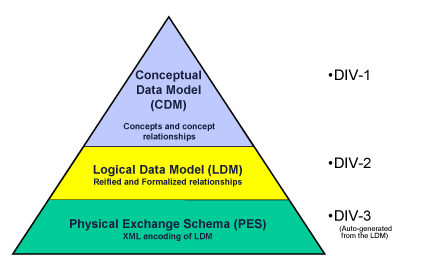DoDAF Meta-Model (DM2)
The Purpose of the DoDAF Meta Model (DM2)
The purpose of DoDAF is to define concepts and models usable in DoD’s six core processes:
- Capabilities Integration and Development (JCIDS)
- Planning, Programming, Budgeting, and Execution (PPBE)
- Acquisition System (DAS)
- Systems Engineering (SE)
- Operations Planning
- Capabilities Portfolio Management (CPM)
In addition, DoDAF 2.0’s specific goals were to:
- Establish guidance for architecture content as a function of purpose – “fit for purpose”
- Increase utility and effectiveness of architectures via a rigorous data model – the DoDAF Meta Model (DM2) -- so the architectures can be integrated, analyzed, and evaluated to mathematical precision.
The purposes of the DM2 are:
- Establish and define the constrained vocabulary for description and discourse about DoDAF models (formerly “products”) and their usage in the 6 core processes
- Specify the semantics and format for federated EA data exchange between:architecture development and analysis tools and architecture databases across the DoD Enterprise Architecture (EA) Community of Interest (COI) and with other authoritative data sources
- Support discovery and understandability of EA data:
- Discovery of EA data using DM2 categories of information
- Understandability of EA data using DM2’s precise semantics augmented with linguistic traceability (aliases)
- Provide a basis for semantic precision in architectural descriptions to support heterogeneous architectural description integration and analysis in support of core process decision making.
The DM2 defines architectural data elements and enables the integration and federation of Architectural Descriptions. It establishes a basis for semantic (i.e., understanding) consistency within and across Architectural Descriptions. In this manner, the DM2 supports the exchange and reuse of architectural information among JCAs, Components, and Federal and Coalition partners, thus facilitating the understanding and implementation of interoperability of processes and systems. As the DM2 matures to meet the ongoing data requirements of process owners, decision makers, architects, and new technologies, it will to a resource that more completely supports the requirements for architectural data, published in a consistently understandable way, and will enable greater ease for discovering, sharing, and reusing architectural data across organizational boundaries.
To facilitate the use of information at the data layer, the DoDAF describes a set of models for visualizing data through graphic, tabular, or textual means. These views relate to stakeholder requirements for producing an Architectural Description.
What and Where is the DM2
In accordance with standard data modeling conventions, the DM2 has several levels, as shown in the figure below.

DM2's Three Levels
Each of these is important to a particular viewer of Departmental processes.
- The conceptual level or Conceptual Data Model (CDM) defines the high-level data constructs from which Architectural Descriptions are created in non-technical terms, so that executives and managers at all levels can understand the data basis of Architectural Description.
- The Logical Data Model (LDM) adds technical information, such as attributes to the CDM and, when necessary, clarifies relationships into an unambiguous usage definition.
- The Physical Exchange Specification (PES) consists of the LDM with general data types specified and implementation attributes (e.g., source, date) added, and then generated as an XSD.
The DM2 consists of the following data items:

The LDM can be obtained here.; PES can be obtained here.
This DoDAF site contains CDM as well as LDM, PES, and ontology documentation.